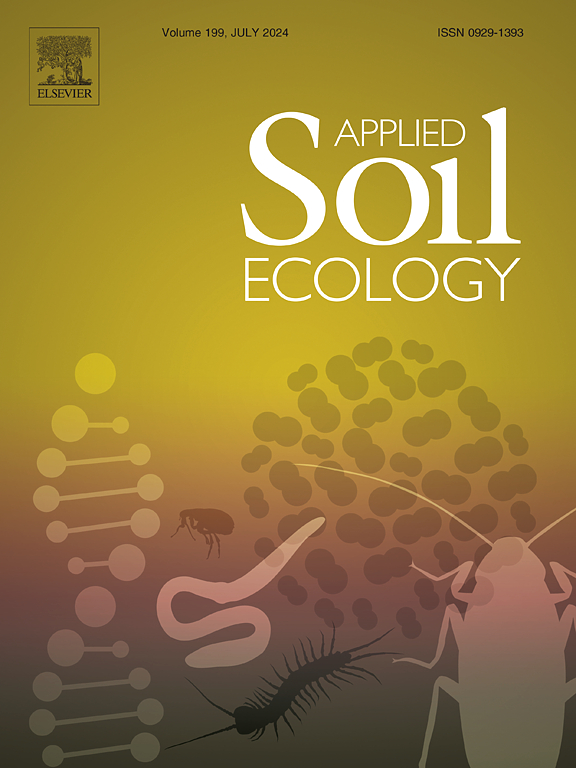Woody stem and root litters influence soil carbon decomposition through enzyme activities in boreal peatland
IF 5
2区 农林科学
Q1 SOIL SCIENCE
引用次数: 0
Abstract
Under the context of climate warming, the increased abundance of woody plants in boreal peatlands introduces uncertainty to the peatland soil carbon balance. This study aimed to investigate the effect of the input and decomposition of woody litter on the CO2 emissions of boreal peatland. Woody litters from two plant organs (stem and root) of four plant species, i.e., two shrub species (Vaccinium uliginosum and Chamaedaphne calyculata) and two tree species (Betula platyphylla and Larix gmelinii), were collected from a boreal peatland in northeast China and incorporated into the peat soil collected from northeast China for 100-day laboratory incubation experiments under various temperatures and soil moistures. The results showed that while the input and decomposition of woody litter increased CO2 emissions by 130 %–210 %, the addition of woody litter had no significant effect on the temperature sensitivity of peat soil CO2 emissions. Among the eight types of woody litters, the tree-type litters and root litters showed faster decomposition and higher accumulated CO2 emissions compared to the shrub-type litters and corresponding stem litters, respectively, which could be attributed to low C/N ratios of tree-type litters and root litters. In addition, the temperature and soil moisture influenced the soil enzyme activities and thereby greatly impacted the woody litter decomposition and CO2 emissions. The temperature increase and soil moisture decrease enhanced the woody litter decomposition and CO2 emissions. The results of this study contribute to a better understanding of the effects of woody litter input and decomposition on CO2 emissions from boreal peatlands, providing theoretical support for evaluating the impact of continuous climate warming on the carbon balance of boreal peatlands.
北方泥炭地木本茎、根凋落物通过酶活性影响土壤碳分解
气候变暖背景下,北方泥炭地木本植物丰度的增加给泥炭地土壤碳平衡带来了不确定性。本研究旨在探讨凋落木的输入和分解对北方泥炭地CO2排放的影响。以东北北方某泥炭地为研究对象,采集了2种灌木(Vaccinium uliginosum)和Chamaedaphne calyculata)和2种乔木(Betula platyphylla)和落叶松(Larix gmelinii) 4种植物的2个器官(茎和根)木本凋落物,并将其放入东北泥炭土中,在不同温度和土壤湿度下进行了100天的室内培养实验。结果表明,凋落木屑的输入和分解增加了130% ~ 210%的CO2排放,而凋落木屑的添加对泥炭土CO2排放的温度敏感性没有显著影响。8种类型的木本凋落物中,乔木型凋落物和根系凋落物分别比灌木型凋落物和相应的茎干凋落物表现出更快的分解和更高的CO2累积排放量,这可能是由于乔木型凋落物和根系凋落物的C/N比较低所致。此外,温度和土壤湿度影响了土壤酶活性,从而极大地影响了木本凋落物的分解和CO2的排放。温度升高和土壤水分减少促进了木本凋落物的分解和CO2的排放。本研究结果有助于更好地了解凋落物输入和分解对北方泥炭地CO2排放的影响,为评估气候持续变暖对北方泥炭地碳平衡的影响提供理论支持。
本文章由计算机程序翻译,如有差异,请以英文原文为准。
求助全文
约1分钟内获得全文
求助全文
来源期刊

Applied Soil Ecology
农林科学-土壤科学
CiteScore
9.70
自引率
4.20%
发文量
363
审稿时长
5.3 months
期刊介绍:
Applied Soil Ecology addresses the role of soil organisms and their interactions in relation to: sustainability and productivity, nutrient cycling and other soil processes, the maintenance of soil functions, the impact of human activities on soil ecosystems and bio(techno)logical control of soil-inhabiting pests, diseases and weeds.
 求助内容:
求助内容: 应助结果提醒方式:
应助结果提醒方式:


